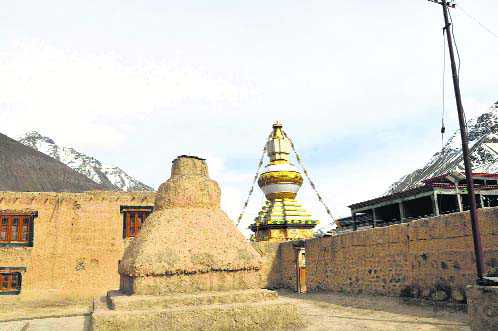Pratibha Chauhan
Tribune News Service
Shimla, January 5
With the very existence of the over 1,000-year-old Tabo monastery in Lahaul Spiti being buffeted by environmental changes, the Himachal Pradesh Government plans to rope in conservation architects and eminent experts to save the pristine monument from further decay.
The Department of Language, Art and Culture plans to take all necessary steps that are required to save the monastery, a symbol of Himalayan Buddhist culture, from being lost to the vagaries of nature.
The department plans to hold a brainstorming session by taking all eminent experts to Tabo so that the problems can be minutely looked into and remedial measures be taken at the earliest.
With mud and wooden structure facing a lot of seepage, resulting in decay of the woodwork and threatening the paintings, there is need for taking immediate steps to protect it against changing climatic conditions in the form of heavy rainfall.
The most visible impact of climate change is being witnessed in the form of heavy rain, with only very light rainfall or snow taking place in the past. The Tabo monastery is one of the most precious monuments which remains a seat of Himalayan Buddhist culture and is valued for its exceptional quality of structure and decorative paintings that adorn its walls and roof. The portraits
and idols inside the monastery too lend immense archaeological importance to the monastery.
“The damage is a matter of concern for us. To ensure that it does not suffer any further loss, we want that whatever is required to be done is done as per strict technical advice,” said Upma Chawdhry, Additional Chief Secretary, Language, Art and Culture.
She said the moment the weather permits, all experts, including the Director General of the Archaeological Survey of India (ASI), will examine the damage caused to the monastery, the vulnerability of the 10th century structure and other critical factors which are a potent threat to the survival of the monastery. The monks at the monastery too have requested the authorities to take immediate steps to save the structure from further damage. Though he ASI has taken certain steps to protect it, it is being felt that remedial measures on a large scale need to be taken urgently.
It was in 1972 that Tabo monastery was declared a monument of national importance and put under the control of the ASI. However, the Tabo monastic complex, in the last decade, has begun to show signs of wear due to excessive seepage on account of heavy rain, a phenomenon triggered by climate change. A recent study has showed that the increasing wet conditions, which reflect the large-scale intensification of the hydrological cycle, are the factors posing a threat to the monument.
Unlock Exclusive Insights with The Tribune Premium
Take your experience further with Premium access.
Thought-provoking Opinions, Expert Analysis, In-depth Insights and other Member Only Benefits
Already a Member? Sign In Now










